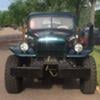A friend and member here (TT) replaced his with stainless several years ago, zero issues and screws look like new. When my bucket of white tip steel screws runs out I will probably go that route.
#11

Posted 12 October 2018 - 06:31 PM
Sunman2003 Four Wheel Camper -Hawk
2023 All Terrain Camper - Panther 2006 Toyota Tundra Double Cab Limited 4WD
2017 Toyota Tundra Double Cab Limited 4WD
#12

Posted 15 October 2018 - 04:53 AM
Use stainless and dip each fastener in a quality sealant, such as 3M or Silka, and you won't have any issues.
#13

Posted 15 October 2018 - 06:50 PM
<Use stainless and dip each fastener in a quality sealant, such as 3M or Silka, and you won't have any issues.>
As long as the sealant is between the head of the fastener and the Aluminum as well as between the threads and the Aluminum - I concur.
Regards,
Craig
1993 Dodge Cummins W-250 Club Cab long bed, 2007 FWC Keystone
#14

Posted 16 October 2018 - 02:54 AM
Yup, "wet" sealant is the way they would fasten at Boeing. The new carbon wings (787, 777X) have aluminum ribs against the carbon fiber reinforced plastic (CFRP) wing skins. They use sealant between since there is a galvanic battery between those. Occasionally they use "wipe on/wipe off primer" to fill voids with primer. Many of the fasteners have special (i.e., expensive) coatings to help out. Anyway, it sounds like good advice to coat the screws before installing.
Tacoma/Fleet 2018.
#15

Posted 16 October 2018 - 05:07 PM
Except that the mechanics of how the screw goes into the joint is different than it is with a rivet. In the case of the screw there is a continuous wiping action on the load-bearing side of both the male and the female thread and between the underside of the screw-head and the top panel for the duration of the screw being twisted into place. That wiping action may or may not be removing all of the sealant/isolation film, but it is sure to remove some of it thus completing the galvanic corrosion circuit. Which means that the assembly's seal against moisture becomes critical to preventing corrosion around the fastener. Once that seal is breached the process will start because there is no back-up.
If the fasteners chosen are, say, galvanized, then the metal in contact with the aluminum is Zinc. If you look up Zinc's position in a galvanic potential table you'll find it right next to aluminum. Which means that the galvanic potential is very, very low. Said differently it makes an extremely weak battery. Add the sealant to that assembly and you have a two stage protection scheme.
Where does that road go?
#16

Posted 16 October 2018 - 10:50 PM
The Galvanic process requires an electrolyte on both surfaces. If the sealant prevents the electrolyte from wetting both materials galvanic corrosion can't occur. For that reason I advised making sure there is sealant under the head and on the threads. The sealant between the head of the fastener and the skin of the camper should actually be sufficient to keep the threads dry. The sealant on the threads helps lock the fastener in place and adds a little insurance.
Therefore, I think the issue of the sealant being completely removed from the threads is not worth worrying about - keep in mind only a thin film is actually needed on the surface of the material to keep the electrolyte from causing a problem anyway and it is unlikely that all of the sealant will be wiped off.
All that written the potential difference between Zinc and Aluminum as well as Cadmium and Aluminum is small. One could use Zinc or Cadmium plated fasteners and probably not have an issue except perhaps in salty coastal environments.
However, the same concern raised about e sealant during installation applies to plated fasteners. What happens when the fastener is threaded into the part? One needs to be sure that the plating is robust so it doesn't flake off and there probably will be some plating removed during the threading process.
It seems to me that a belts and suspenders approach would be to use Zinc or Cadmium plated fasteners and a sealant or non-metallic washer under the fastener head and perhaps even putting sealant on the threads as well.
I hope this is helpful.
Craig
1993 Dodge Cummins W-250 Club Cab long bed, 2007 FWC Keystone
#17

Posted 16 October 2018 - 11:47 PM
My poorly made point was that the action of screwing a threaded fastener into a hole will wipe at least some of the sealant off and result in some metal to metal contact or exposure within the threads. It won't wipe all of it off, but it doesn't need to in order to set up the start of a problem. Same with the under-head area, though less so. It might seal initially, but with time and even a tiny bit of relative motion the seal could quite easily be broken. The quality, flexibility, and durability of the sealant chosen will be crucial.
In my experience the biggest problem with plated fasteners is the quality of the plating. Which is generally pretty poor on hardware store sourced fasteners. The idea of buying mil-spec, the only way that I know of to get quality plating, seems abhorrent and exceedingly expensive given the application. Not sure what the solution for this is.
Where does that road go?
#18

Posted 17 October 2018 - 12:11 AM
#19

Posted 17 October 2018 - 02:59 AM
I think you guys are trying to solve a problem that doesn't exist. I replaced all the roof screws on my 1977 Grandby a couple of years ago. All the exposed screw heads were rusty, some even starting to deteriorate. None of the screw bodies were rusty. And replacement screws of the same size tightened up nicely. The few screws I pulled on the side windows were in the same condition.
jim
#20

Posted 17 October 2018 - 02:55 PM
It may not exist in Minn., but its a big deal here on the Coastal Desert where we frequently have a marine layer condensing on anything metallic. We've discussed this regional variability in the past.
Where does that road go?
0 user(s) are reading this topic
0 members, 0 guests, 0 anonymous users


















